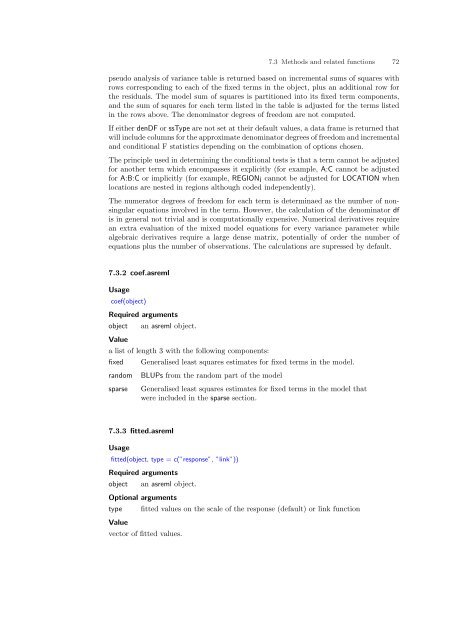7.3 Methods and related functions 72pseudo analysis of variance table is returned based on incremental sums of squares withrows corresponding to each of the fixed terms in the object, plus an additional row forthe residuals. The model sum of squares is partitioned into its fixed term components,and the sum of squares for each term listed in the table is adjusted for the terms listedin the rows above. The denominator degrees of freedom are not computed.If either denDF or ssType are not set at their default values, a data frame is returned thatwill include columns for the approximate denominator degrees of freedom and incrementaland conditional F statistics depending on the combination of options chosen.The principle used in determining the conditional tests is that a term cannot be adjustedfor another term which encompasses it explicitly (for example, A:C cannot be adjustedfor A:B:C or implicitly (for example, REGION¡ cannot be adjusted for LOCATION whenlocations are nested in regions although coded independently).The numerator degrees of freedom for each term is determinaed as the number of nonsingularequations involved in the term. However, the calculation of the denominator dfis in general not trivial and is computationally expensive. Numerical derivatives requirean extra evaluation of the mixed model equations for every variance parameter whilealgebraic derivatives require a large dense matrix, potentially of order the number ofequations plus the number of observations. The calculations are supressed by default.7.3.2 coef.asremlUsagecoef(object)Required argumentsobject an asreml object.Valuea list of length 3 with the following components:fixed Generalised least squares estimates for fixed terms in the model.randomsparseBLUPs from the random part of the modelGeneralised least squares estimates for fixed terms in the model thatwere included in the sparse section.7.3.3 fitted.asremlUsagefitted(object, type = c(”response”, ”link”))Required argumentsobject an asreml object.Optional argumentstype fitted values on the scale of the response (default) or link functionValuevector of fitted values.
7.3 Methods and related functions 737.3.4 plot.asremlUsageplot(object, option=c(”v”, ”f”, ”r”, ”t”), forceMET=”separate”variogram = plot.asreml.default(object)$variogram,resid.form = plot.asreml.default(object)$resid.form,fitted.form = plot.asreml.default(object)$fitted.form,trend = plot.asreml.default(object)$trend,display=T, spatial=”plot”, npanels=list(v=NA,f=NA,r=NA,t=20), ...)Required argumentsobjectOptional argumentsoptionforceMETvariogramresid.formfitted.formtrenddisplayspatialan asreml object.if one or more of v, f, r or t is specified then diagnostic plots including thesample variogram, fitted values, residuals and trends in residuals are produced.if not ”none”, the option argument is ignored and an alternative set ofplots of the sample variogram and trends in residuals is produced for Multi-Environment Trials. If ”separate” (the default) each sample variogram and eachresidual plot for each trial appears in a separate frame. If ”together”, the samplevariogram and residual plot appear in a single frame for each trial. If ”none”then the default ploting method is used.a trellis graphics formula, with no response specified, suitable for wireframe() orxyplot() depending on dimension. The x, y and any conditioning variables mustappear in the model frame; the response is created internally from resid(object)after any subset and missing value methods have been applied. For example, ∼Row*Column | Location creates a wireframe() panel for each level of Location.a trellis graphics formula ,suitable for histogram(). Currently the x-variablemust be the keyword Residuals.a trellis graphics formula suitable for xyplot() Currently no response is allowedand the x-variable must be the keyword Residuals.a list of trellis graphics formulae suitable for xyplot() Currently no response isallowed, the keyword Residuals is used internally. The x-variable and conditioningvariables must be objects in the model frame. A trellis object is created foreach formula in the list. For example, trend = list(∼ Row | Column) results ina multipanel plot of residuals against Row conditioned on Column.The plots are produced as a list of trellis objects. If display=TRUE then theseobjects are printed.If “plot” and an independent error has been fitted with units in the randomformula, these are added to the residuals, otherwise if “trend” then units arenot added even if present in the model.npanels A list specifying the maximum number of panels per page. If NA then a suitabledefault is determined.... graphical parameters can be supplied to plot.asreml().ValueAn invisible list of trellis graph objects is produced. Up to 4 diagnostic plots are produced:(v) the sample variogram, (f) fitted values versus residuals, (r) distribution of residualsand (t) trends in residuals using any factors specified in the R component of the model.If more than one trellis plot is requested then they appear as separate pages (MicrosoftWindows) or a dialogue is started for interactive viewing (SUN Solaris).
















